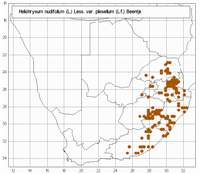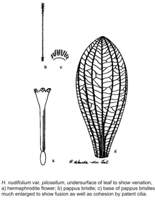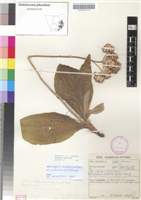Common names:
Cholocholo, Isidwabasokhovu, umgademthina. (Z); Hottentot's tea (E), Hottentottee (A), Mohlomela-tsie (SS), Umagada-emthini (Z)
Origin of name:
nudi = hairlessfolium = leaves
Diagnostic characters:
RosetteBroad leavesLarge heads in large compact inflorescencesBrown bracts
Description:
Perennial herb, roots fusiform, tuberous, rootstock stout, woody, crowned with old fibrous leaf-bases which are brown silky-woolly, flowering stem terminal, simple, 150�600 mm tall, often leafy at the base only, more rarely distantly leafy upwards, woolly-felted. Leaves often only 3 or 4, spreading or ascending, up to 150 (�230) x 40 (�60) mm, elliptic, ovate or subrotund, narrowed to a broad clasping base, stem leaves, if present, cordate-clasping, shortly decurrent, apex obtuse or subacute, upper surface harshly pubescent with long coarse multicellular hairs or scabridulous, lower white-felted, strongly 5�9 nerved, reticulate. Heads homogamous, campanulate, c. 5 x 5 mm, many in compact corymbose clusters in a rounded or flat-topped cyme. Involucral bracts in c. 3 series, imbricate, subequal, about equaling the flowers, base woolly, tips more or less obtuse, crisped, pellucid, pale brown, minutely radiating. Receptacle with fimbrils longer than ovaries. Flowers (20�)23�58(�60), bright yellow or orange. Achenes c. 1 mm long, glabrous. Pappus bristles many, equaling corolla, scabrid, bases lightly cohering by patent cilia, lightly fused as well.
Flowering mainly between August and December.
Distribution:
Widespread in regularly burnt upland grassland or Protea grassland, also in the forest zone, down to sea level in KwaZulu-Natal, Transkei and Eastern Cape. Ranges from Congo, Uganda, Kenya, Tanzania, Zambia, Malawi, Mozambique and Zimbabwe to all the provinces in South Africa, Swaziland and Lesotho; in the Cape about as far west as Uitenhage and Galgebosch (roughly 25�E).
Grassland and Savanna Biomes.
Taxonomy:
Literature:
Helichrysum nudifolium (L.) Less. var. pilosellum (L.f.) Beentje in K.B. 55: 359 (2000).
Type:
Cape of Good Hope, B�ck / Forster s.n. (LINN 989.79).
Synonym(s):
Gnaphalium pilosellum L. f., Suppl. 364 (1781).
G. latifolium Thunb., Prodr. 152 (1800), Fl. Cap. 660 (1823). Helichrysum latifolium (Thunb.) Less., Syn. Comp. 297 (1832); DC., Prodr. 6: 198 (1838); Harv. in F.C. 3: 237 (1865); Moeser in Bot. Jb. 44: 262 (1910). Type; Cape, Galgebosch, Thunberg (sheet 19183, UPS).
Helichrysum pilosellum (L.f.) Less., Syn. Comp. 297 (1832) quoad syn. excl. descr.; Hilliard & Burtt in Notes R. bot. Gdn Edinb. 32: 358 (1973); Compton, Fl. Swaziland 633 (1976); Hilliard, Compositae in Natal 172 (1977). Type: Cape of Good Hope, B�ck [i.e. Forster] (LINN 989.79).
H. latifolium var. reticulatum Harv. in F.C. 3: 237 (1865). Type: KwaZulu-Natal, between Pietermaritzburg and Ladysmith, Gerrard & M'Ken 281 (TCD).
H. pedunculare (L.) DC. var. pilosellum (L. f.) Harv. in F.C. 3: 238 (1865) quoad syn., excl. spec.
Vouchers:
Compton 27079 (NBG); Devenish 1606 (E; K; MO; NU; S); Strey 7648 (NU); Tyson 1101 (BOL).

_sml.jpg)
_sml.jpg)
_sml.jpg)
_sml.jpg)
_sml.jpg)
_sml.jpg)
